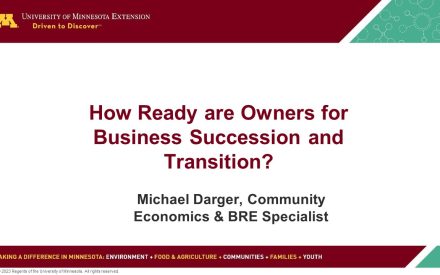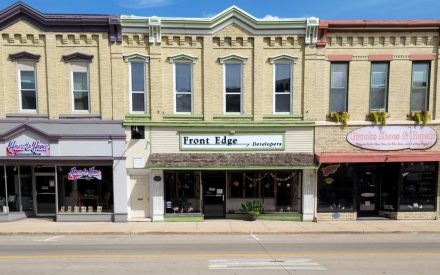
Related Content
April 2022 — This section outlines ways to use your market analysis to support entrepreneurship in your downtown or business district. Entrepreneurship represents the capacity and willingness of an individual(s) to undertake a venture, with its risks, in an effort to achieve a profit. Entrepreneurship has always been important to downtowns and business districts, serving as a catalyst for business formation and its positive ripple-effect in the local economy.
It’s important to understand who entrepreneurs are and what they wish to accomplish. There are several ways of defining and understanding the entrepreneur. The American Heritage Dictionary defines an entrepreneur as a person who organizes, operates, and assumes risk for a business venture. They design, produce, and generate value through creation and expansion of economic activity by identifying new products, processes, and markets. (Ahmed & Hoffman, 2008). They have specific ideas about why their business fills a need in a region. Entrepreneurs are often creative forces who have the capacity to see change as opportunity, and as such, they adapt well to new environments and challenges they may face (Greg Wise, 2009). For purposes of the discussion in this chapter, we simply consider an entrepreneur anyone who creates, or owns or manages a business, including nonprofits.
According to the Kauffman Foundation, “economic gardening is a model that embraces the fundamental idea that entrepreneurs drive economies. It seeks to create jobs by supporting existing companies in a community.” It requires long-term investment and reliance on multiple small operations, but the payoff includes stability and diversification among locally-held interests. The following ideas were derived in part from economic gardening principles.
Using Information to Identify Potential Entrepreneurs
Part I of the toolbox provides methods to help you collect information to better understand your market. This includes information on who lives in the community or trade area, and what entrepreneurial talent might exist there. This data can be used to find entrepreneurs who might be a good fit for your downtown.
Entrepreneurs, especially in the pre-venture and early start-up stages without a visible storefront, can be a challenge to identify. Many seek to keep overhead low and operate out of their home as long as possible. Many will never need a storefront (mobile businesses, online retail, etc.), and others value the fact that they can work from home or be established in areas away from the city center. Gatherings and social media groups specifically for entrepreneurs, and word of mouth are some initial ways to learn who is operating an enterprise or seeking to start one locally. Entrepreneurs, as independent-minded, free thinkers, often don’t seek help or ask for it when they need it, so business development professionals may be the ones to make most initial contacts, describing services they could provide when the time is right for the business owner to follow up.
Importantly, many home-based and small businesses with no employees are owned by women and people of color who experience numerous barriers to starting and scaling businesses (Blanchard, Zhao & Yinger, 2008; Hammer & Malual, 2020; Pantin, 2018; ). As a whole, they have more limited capital and networks than men and white business owners, meaning they may find it less feasible to grow out of their home or add employees since they are often funding their startup out of pocket.
For downtown development professionals, relationship building with individual entrepreneurs is the number one tool to effectively support new business creation. Rather than focusing on the business, a focus on the individual entrepreneur is recommended (Lichtenstein, Lyons, & Kutzhanova, 2004) since an individual with effective support and capacity could go on to create many more businesses over their lifetime. Understanding their goals, business and industry-specific experience, and current business needs clearly is essential. Not everyone will need the same kinds of supports or be interested in the same kinds of opportunities. Having solid relationships will allow the development team to provide what is needed for the people who are there now, rather than relying on programs that have worked in other places for different entrepreneurs (Lichtenstein, Lyons, & Kutzhanova, 2004). For example, for those whose industry could eventually expand to a storefront, it may be important to demonstrate why sales and profit might be higher if based out of a downtown location. That same pitch to a person happy at home because of child care needs and not intending to scale would fall flat, though this entrepreneur may be very interested in structured network gatherings.
Some entrepreneurs will understand the importance to their business of having a physical presence downtown. Others might be amenable to the idea if some assistance or incentives were provided. For those entrepreneurs who might need some assistance in getting started, an incubator or similar program may be helpful.
In addition to home-based businesses, businesses without paid employees are an important segment of the economy to consider for potential downtown locations. Similar to home-based businesses, these small one-person businesses, or solopreneurs, are less visible, but given the right conditions, are primed to grow into employer-businesses that may be served well by a central location. Maximizing their strengths and addressing their challenges is an important component of developing a diverse business community.
How Towns Have Identified Potential Entrepreneurs
For specific examples of how towns have identified local entrepreneurs, see the Small Towns Big Ideas web site from the University of North Carolina – Chapel Hill.
Example: Fairfield, Iowa – Population: 9,500: Fairfield had a successful project combining entrepreneurship and downtown revitalization by focusing on establishing entrepreneurial networks and relationships. It’s now known as the “Silicorn” Valley, but it didn’t get there until it took steps toward identifying their assets and embracing the diversity that came with it. After losing Barrow College, the town turned to longtime assets, like agricultural innovation and broadband communications. In the meantime, a new tenant bought the old campus and started a new school with a focus on Eastern-style meditation. Though this at first created a culture clash for the traditional Upper Midwestern town, Fairfield ended up embracing the new institution. Additionally, a commitment was formed between developers and entrepreneurs to creating a strong sense of civic duty and pride, resulting in a successful mentoring program for entrepreneurs. It’s resulted in a town dedicated to growing jobs and committed to each other.
Entrepreneur’s Self-Evaluation and Opportunity Screening Guides
Less of a concern for downtown directors, but of great importance to emerging entrepreneurs, is the opportunity for self evaluation and analysis during the first stages of starting a business. The following are tools and resources that aim to help new businesses identify their strengths and assess the feasibility of their new business venture.
- Business Feasibility: A First Cut Analysis
- Growing Entrepreneurs from the Ground Up
- New Venture Creation: Entrepreneurship for the 21st Century (6th edition), by Jeffrey A. Timmons and Stephen Spinelli.
Using Your Market Analysis
Use information from your market analysis to find clues about prospective entrepreneurs. Some of the relevant market analysis information to consider includes:
- Feedback from the business owner’s survey. Look for suggestions or characteristics of a person who might have the entrepreneurial talent to carry out an innovative idea. Look for “red flags” identified by business operators that might be obstacles hindering business formation.
- Responses from focus group sessions or interviews might give clues to particular business ideas or entrepreneurial talent in the community.
- Findings from a peer city comparison that offers examples of entrepreneurship development that may be transferable to your community.
- Examination of local and regional economic data to determine if there are any natural entrepreneurial spin-offs that might result given the current industrial mix in your community.
Be alert throughout the process for opportunities to support business succession. Match current business owners who are considering a transition to another position or retirement and with a budding entrepreneur who may be interested in taking over the business. Structured mentor pairing can be positive for experienced business people interested in giving back and for incoming business owners to learn from the best. This program benefits all participants and especially women and people of color who are less likely to have experienced business people in their close social circles.
Providing Supportive Infrastructure
Economic gardening works best when a commitment is made to invest in the business environment to ensure a healthy start for entrepreneurs. It’s important to remember that the relationship here is mutual: you’re investing in their entrepreneurial talent and they’re investing in your downtown.
Types of Infrastructure
Chris Gibbons has this to say about the importance of supporting not only entrepreneurs, but the space around them: “Community development is economic development, and a sound infrastructure is the starting point.” A look at your current infrastructure can reveal ways your district could be more accommodating to entrepreneurs. Infrastructure can include:
- Available and affordable commercial spaces and building stock;
- Technology: including strong cellular coverage and WiFi or broadband Internet service;
- Inviting public spaces, like parks, sidewalks and gathering spaces;
- Walkable streets with pedestrian-friendly information;
- Public transportation;
- Child- and eldercare;
- Information to help prospective entrepreneurs understand characteristics of the trade area;
- Financing including angel investment and micro-enterprise loan programs;
- Incubator programs providing technological and other business-related skills, as well as financial support, during the business’s first few years; and
- Business counseling and education programs such as those offered by the Small Business Development Centers (SBDC) or SCORE business counseling services.
- Coworking spaces that provide temporary office space, meeting rooms, and networking opportunities for those not ready to invest a leased or purchased office yet
Incubators
Business incubators are facilities that often provide a physical space, support, resources, and business services for emerging small business owners. Entrepreneurs are provided assistance with tasks such as writing and maintaining a business plan, marketing, and accounting. As reported in the 2004 Main Street News article “Incubators: Nurturing Small Business Growth,” a 1997 US Dept of Commerce study reported that 87% of incubator graduates remained in business. In contrast, the Small Business Administration reports that 80% of small businesses fail within their first five years.
The Small Business Administration lists three things that incubator facilities typically have:
- Location of the entrepreneurs in a common space at a rent that is below average for the area or an exceptional value for the services provided;
- Shared equipment or services to lower the businesses’ initial capital needs; and
- Management assistance and access to professional expertise.
Other incubators are virtual and do not require a “bricks and mortar” location.
The chosen entrepreneurs agree to be members for a specified period of time, often going through various trainings and/or being paired with an established, successful entrepreneur in the community to receive mentoring. Incubators that establish cohorts of entrepreneurs and utilize a structured curriculum have been found to be especially successful.
An incubator can take on many forms. Some focus on specific industries. For instance, if a downtown would like to be a magnet for culinary-related businesses, an incubator with other food service tenants and a shared industrial kitchen might be an excellent fit. Resources specific to food incubators and community kitchens are available from the UW-Extension Food Business Network. Incubators can also serve as a test to see what businesses might be viable in your downtown district. Some incubators function very simply, merely as an office for the entrepreneurs, while others might participate to generate sector development between businesses.
Using Your Market Analysis
The strengths and weaknesses of your districts infrastructure as it relates to entrepreneurship can be examined using data from your market analysis:
- Feedback from the business owner’s survey. The survey asks numerous questions related to needed physical improvements, business assistance and training, and other services that would benefit the downtown business community.
- Responses from focus group sessions or interviews. A sample question that might provide insight on your district’s infrastructure by asking existing business owners how a downtown location is advantageous (or disadvantageous) to their company?
- Findings from a peer city comparison that offers examples of innovative entrepreneurial assistance programs and services.
Connecting Entrepreneurs with Peers and the Community
In addition to appropriate services and built capital, entrepreneurs need supportive relationships from other entrepreneurs and non-entrepreneurs alike. Fellow entrepreneurs can offer mentorship and be an important source of timely and locationally specific information about how to run a successful business. Non-entrepreneurs and community members at-large can also offer their support and encouragement. In this way, fostering local attitudes around failure and risk-taking that support entrepreneurial behavior is an important component of a community development approach to supporting new businesses.
One of the most important things emerging entrepreneurs can do is network and meet local business owners and entrepreneurs, local government officials, business service providers, and key community members. Because many entrepreneurs work alone, opportunities to reach out and talk with a larger network can be very beneficial.
Expanding and strengthening the network of entrepreneurs more generally lends itself to greater information sharing and access to resources. Women and people of color are often less-networked which has real consequences for their experience as an entrepreneur. Intentionally making connections and bridging different groups within the community can be part of supporting a diverse downtown community.
Making Connections
Some places develop mentoring programs where emerging entrepreneurs are paired with successful ones, such as the program in Fairfield, Iowa. It is argued by some that most of what entrepreneurs learn is from their peers or their own experience, not economic development professionals, books, or classrooms.
Formal and informal places can be used to connect entrepreneurs. In Fairfield, the library, coffee shops, restaurants, and bookstores have become convenient and low cost meeting places. Restaurants in particular have become business networking places at lunchtime.
Inventor & Entrepreneur (I&E) Networks are clubs that provide a place for entrepreneurs with an opportunity to discuss their business with like-minded people. These networks might provide emerging entrepreneurs with opportunities for growth through trainings on a variety of topics. They provide a place for innovation, confidential discussion, and support. Participants in these I&E clubs reported the top three benefits of participating were networking, education, and gaining access to information.
In Wisconsin, the Wisconsin Entrepreneurs’ Network (WEN) serves as a statewide network for entrepreneurs that provides resources to help businesses move forward. This network connects entrepreneurs with peers as well as valuable technical resources.
Creating a Community Climate Supportive of Entrepreneurs
Creating a community climate that is amenable to entrepreneurs helps a community at large understand its assets and assist economic development. In Energizing Entrepreneurs, researchers with the Rural Policy Research Institute’s Center for Rural Entrepreneurship identified characteristics of attitudes that truly support entrepreneurs and their initiatives.
- Awareness of the potential role of entrepreneurs in economic development and recognizing the challenges new business owners face, including the possibility of failure. “Fair weather support for entrepreneurs will not create an enduring supportive entrepreneurial environment.”
- A culture that realizes that the failure or success of a venture could lead to a shake-up of social harmony. An entrepreneur who is too successful might find themselves outside the mainstream attitudes, while a failure could result in rapid loss of support from former allies.
- Anonymity in smaller communities can be hard to come by. That said, when an entrepreneur tries a new technique or something unusual in the eyes of the greater community, it can be difficult to maintain support when the idea and the person behind it are often viewed as one and the same. Entrepreneurs need space in their community to let their creativity work, and the ability to wear hats as both a resident and an entrepreneur.
- Quality of life is as much a concern to entrepreneurs as it is to other residents. After all, entrepreneurs also have families and are just as concerned about having good schools and other amenities. A community that offers high quality amenities might find that their entrepreneurial retention rate is better than places that don’t emphasize quality of life.
Knowing entrepreneurs are important for job creation, poverty alleviation, and income growth for the community can inspire collective support for the business community and motivate collaborative problem-solving between business owners and non-business-owner community members. A local perspective that values experimentation and risk-taking, and accepts failure, can also encourage entrepreneurs who are on the fence or concerned about how their ambitions will be received by their community.
One way to build this is through Homegrown: Entrepreneurship in Your Community, a program focused on building and strengthening your local entrepreneurial network. Homegrown is a joint effort between UW-Madison Extension and the University of Missouri Extension. The program can be tailored to community members or professionals with a shared interest in learning about entrepreneurship.
Using Your Market Analysis
Your market analysis may provide ideas on how to build connections among entrepreneurs and the community:
- Feedback from the business owner’s survey. The survey asks questions related to opportunities (or lack of opportunities) for entrepreneurs to meet other business and community leaders;
- Responses from focus group sessions or interviews. Findings might provide insight on improving your community’s attitude toward business development and relationships among business operators within the community; and
- Findings from a peer city comparison. Other communities can offers examples of networking events and places that bring the business community together.
Appendix – Community Entrepreneurship
Community Entrepreneurship is a method of providing support and funding for a business idea that benefits or is the idea of the entire community. When a void exists in the marketplace, the market is too slow to act on its own, or the risks are too high for just one investor, community entrepreneurship spreads the responsibility and ownership to multiple parties. Community entrepreneurship initiatives typically have the same goals as other businesses: identify a market need and generate a profit.
The following is an outline of types of community-owned businesses, as offered by Joshua Bloom of the National Main Street Center as reported in the March/April 2010 issue of the National Trust Main Street Center’s publication titled Mainstreet Now.
- Cooperatives are democratic organizations where members have an equal vote; they typically function as not-for-profit organizations. Broadly speaking, there are four types:
- Consumer (retail) Cooperatives
- Worker Cooperatives
- Purchasing Cooperatives (organizations that provide marketing and finance to member businesses and act as a wholesaler)
- Producer Cooperatives (individual producers come together to gain access to larger wholesale and retail markets)
- Community-Owned Corporations – This is a for profit operation where shareholders invest in a business model with membership open to anyone willing to buy a share. Community-owned corporations use democratic voting processes to make decisions.
- Small Ownership Groups – Very similar to community-owned businesses, only that there are fewer owners who are likely to be involved in day-to-day operations.
- Investment Funds – An investment fund serves well in a situation where individuals have interest in supporting an idea, but have no interest in helping to run and manage the business. Their main goal is to provide venture capital, equity, or low-interest loans to entrepreneurs with whom they have trust in success.
Related Resources
Blanchard, L., Zhao, B., and Yinger, J. 2008. “Do lenders discriminate against minority and women entrepreneurs?” Journal of Urban Economics 63(2):467-497. doi.org/10.1016/j.jue.2007.03.001.
Bloom, Joshua. “ How Communities Become Entrepreneurs.” Mainstreet Now. March/April 2010. Main Street National Trust for Historic Preservation.
Creating Entrepreneurial Communities
Entrepreneurial Communities: A Profile
Goetz, S.J. and D. Freshwater. (2001) State-level determinants of entrepreneurship and a preliminary measure of entrepreneurial climate, Economic Development Quarterly, 15, 58-70.
Gibbons, Christian. Economic Gardening: An Entrepreneurial Approach to Economic Development.
Gillotti, Teresa, and Ryan Ziegelbauer. “Seven Components of a Successful Business Incubator.” From Let’sTalk Business. July 2006, Issue 119. University of Wisconsin – Extension.
Glisson, Linda, and Luke Vanbelleghem. “Incubators: Nurturing Small Business Growth.” From MainStreet News. September 2004, Issue 210. Main Street National Trust for Historic Preservation.
Hammer, D. and Malual, J. 2020. “Entrepreneurs of color in Wisconsin: Bridging the gap in resources to mobilize potential.” Community Development 52 (5):1-17. DOI:10.1080/15575330.2020.1854803.
Lichtenstein, Lyons, & Kutzhanova. (2004) Building entrepreneurial communities: The appropriate role of enterprise development activities.” Journal of the Community Development Society 35:1, 5-24.
Markley, et al. Energizing Entrepreneurs: Charting a Course for Rural Communities. 2005. Heartland Center for Leadership Development, RUPRI Center for Rural Entrepreneurship.
Pantin, L.E. 2018. “The wealth gap and the racial disparities in the startup ecosystem.” Saint Louis University Law Journal 62 (2): 419-460.
Pinkovitz, William and Catherine Stover. “Business Feasibility: A First Cut Analysis.” May 2007, University of Wisconsin – Extension.
“Why is Entrepreneurship Important in Community and Economic Development.” August 31, 2010. eXtension.
Wise, Greg. “Wisconsin Inventor and Entrepreneur Clubs: Paving the way for Innovation.” Community, Natural Resources, & Economic Development Impact Report, University of Wisconsin Extension.
Wise, Greg. “Supporting Entrepreneurship Downtown.” From Downtown Economics. May 2009, Issue 153. University of Wisconsin – Extension.
Yenerall, Jackie. “What Entrepreneurs Mean for Your Community, and How Entrepreneurship Can Be Fostered.” Rural Development Paper No. 40, July 2008. The Northeast Regional Center for Rural Development.
About the Toolbox and this Section
The 2022 update of the toolbox marks over two decades of change in our small city downtowns. It is designed to be a resource to help communities work with their Extension educator, consultant, or on their own to collect data, evaluate opportunities, and develop strategies to become a stronger economic and social center. It is a teaching tool to help build local capacity to make more informed decisions.
This free online resource has been developed and updated by over 100 university educators and graduate students from the University of Wisconsin – Madison, Division of Extension, the University of Minnesota Extension, the Ohio State University Extension, and Michigan State University – Extension. Other downtown and community development professionals have also contributed to its content.
The toolbox is aligned with the principles of the National Main Street Center. The Wisconsin Main Street Program was a key partner in the development of the initial release of the toolbox. One of the purposes of the toolbox has been to expand the examination of downtowns by involving university educators and researchers from a broad variety of perspectives.
The current contributors to each section are identified by name and email at the beginning of each section. For more information or to discuss a particular topic, contact us.














 Lac du Flambeau Housing Summit
Lac du Flambeau Housing Summit Special Features on Black, Latino, Asian, and Native Owned Businesses in Wisconsin
Special Features on Black, Latino, Asian, and Native Owned Businesses in Wisconsin


